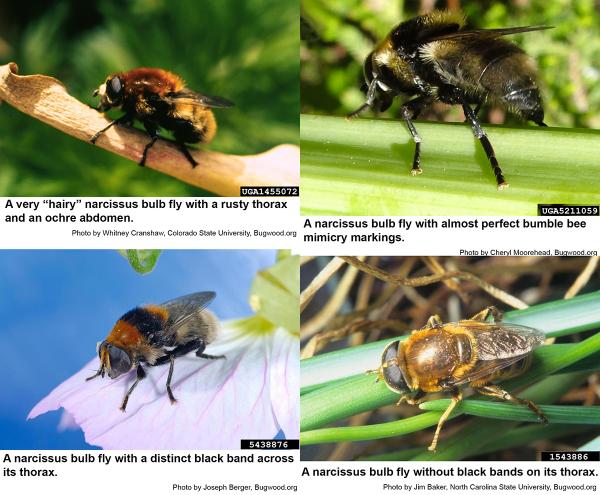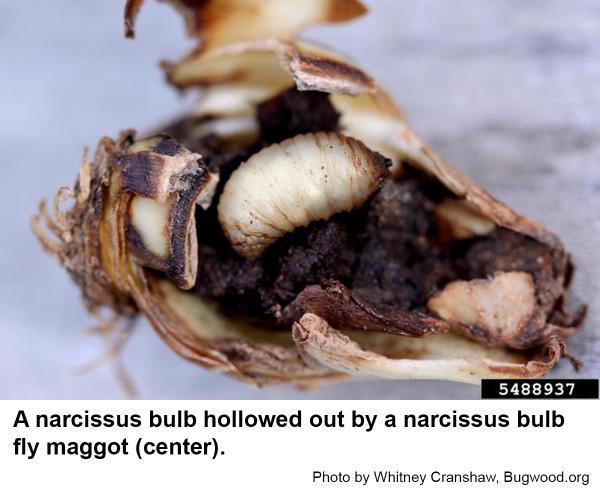Description and Biology
Narcissus bulb flies, Merodon equestris, are 3/8 to 1/2 inch flies that vaguely resemble honey bees or bumble bees in appearance although some bulb flies are more reddish brown, orange or tan than bumble bees occurring in North Carolina. Narcissus bulb flies usually emerge from the soil in May. After mating, females lay one to three eggs between the sheath and stem of the bulb or between the layers of skin enclosing the neck of a bulb. Females lay up to 100 eggs each. Ten days to two weeks later the eggs hatch and the tiny maggots bore down through the outer bulb scales to the basal plate and then directly into the inside of the bulb. Narcissus bulb fly maggots hollow out the center of the bulb and destroy any flower buds. Many infested bulbs rot away although some survive to send up a few scrawny grass-like blades the following year. The maggots develop rapidly and become virtually fully grown in two moths. By that time they are fat and rough skinned. They do not pupate until the following spring. Five to seven weeks are spent in the pupal stage before a new generation of adults emerges in May to continue the wheel of existence.
Host Plants
The narcissus bulb fly has been reported to infest amaryllis, Cyrtanthus, daffodil, Galanthus, Galtonia, Flanthus, Hippeastrum, hyacinth, Iris, lilies, Leucojum, Lycoris, Narcissus, Nerine, Paramongaia, Phaedranassa, Rhodophiala, Scilla, Stenomesson, tulips, and Vallota.
Residential Recommendations
Control of the narcissus bulb fly is not easy. Cultural controls include mowing the leaves as soon as they die down in late spring and then cultivating the soil lightly to prevent the female bulb flies from finding the holes left by the leaves. Lifting bulbs as soon as the tops die back and then sorting out and destroying infested bulbs should also help to decrease bulb flies for the following year. Catching the flies in an insect net and destroying them should also help to decrease the population (each female destroyed means that 100 or so potential maggots are destroyed thus saving 30 or more bulbs).
A hot water bath has also been found to be effective in killing maggots in infested bulbs. Maggots will be killed if bulbs are submerged in water kept at about 110 to 111o F for 40 minutes. Care must be taken to avoid overheating the bulbs even for a short time as the bulbs may be adversely affected by high temperatures.
Spraying the base of flowering bulbs as they die down in spring with an insecticide labeled for home landscape use should help suppress narcissus bulb flies.
References
- Narcissus Bulb Fly. Wilson, D. and D. Dave Karnstedt. 2012 (last modification). Pacific Bulb Society.
- Narcissus Bulb Fly In Insect and Related Pests of Flowers and Foliage Plants. Baker, J. R. editor. 1994 (revised). NC Cooperative Extension Service publication AG-136. 106 pp.
- The bulb flies of narcissus with special reference to the bulb industry in Virginia. Poos, F. W. and C. A Weigel. 1927. Virginia Truck Exp. Sta. Bull. 60: 571-594.
- Extension Plant Pathology Publications and Factsheets
- Horticultural Science Publications
- North Carolina Agricultural Chemicals Manual
For assistance with a specific problem, contact your local Cooperative Extension Center.
This Factsheet has not been peer reviewed.
Publication date: Aug. 6, 2016
Revised: Oct. 9, 2019
Recommendations for the use of agricultural chemicals are included in this publication as a convenience to the reader. The use of brand names and any mention or listing of commercial products or services in this publication does not imply endorsement by NC State University or N.C. A&T State University nor discrimination against similar products or services not mentioned. Individuals who use agricultural chemicals are responsible for ensuring that the intended use complies with current regulations and conforms to the product label. Be sure to obtain current information about usage regulations and examine a current product label before applying any chemical. For assistance, contact your local N.C. Cooperative Extension county center.
N.C. Cooperative Extension prohibits discrimination and harassment regardless of age, color, disability, family and marital status, gender identity, national origin, political beliefs, race, religion, sex (including pregnancy), sexual orientation and veteran status.


